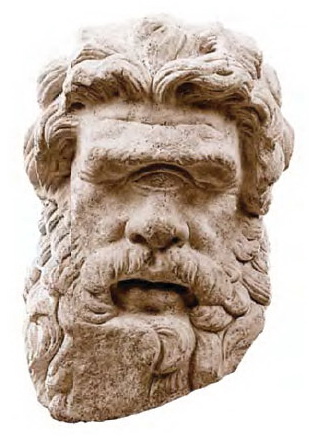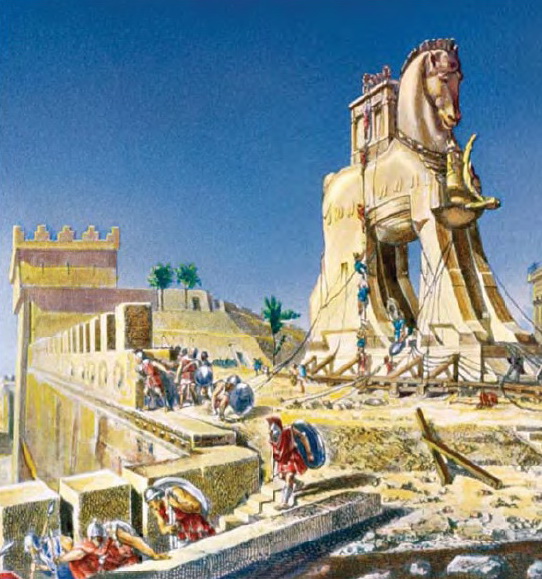Cultures of the Mountains
and the Sea
In ancient times,
Greece was not a united country. It was a collection of separate lands where
Greek-speaking people lived. By 3000 B.C., the Minoans lived on the large
Greek island of Crete. The Minoans created an elegant civilization that had
great power in the Mediterranean world. At the same time, people from the
plains along the Black Sea and Anatolia migrated and settled in mainland
Greece.
|
วัฒนธรรมภูเขาและทะเล
ในสมัยโบราณ
กรีซไม่ได้รวมเป็นประเทศเดียวกัน เป็นการรวมกันขึ้นของดินแดนต่าง ๆ ซึ่งเป็นที่อยู่อาศัยของผู้คนที่พูดภาษากรีก
ประมาณ 3000 ปีก่อนคริสตกาล ชาวไมนวนอาศัยอยู่บนเกาะครีดของกรีกที่มีขนาดใหญ่
ชาวไมนวนได้สร้างอารยธรรมอันสง่าสงามซึ่งมีอำนาจยิ่งใหญ่ในโลกแห่งทะเลเมดิเตอร์เรเนียน
ณ เวลาเดียวกันนั้น เหล่าผู้คนที่มาจากที่ราบตามฝั่งทะเลดำและอานาโตเลียได้อพยพและตั้งหลักแหล่งในประเทศกรีซแผ่นดินใหญ่
|
|
Geography Shapes
Greek Life
Ancient Greece
consisted mainly of a mountainous peninsula jutting out into the Mediterranean
Sea. It also included about 2,000 islands in the Aegean and Ionian seas.
Lands on the eastern edge of the Aegean were also part of ancient Greece.
(See the map.) The region’s physical geography directly shaped Greek
traditions and customs.
|
ภูมิประเทศสร้างสรรค์ชีวิตของชาวกรีก
กรีซสมัยโบราณส่วนใหญ่ประกอบด้วยคาบสมุทรที่เต็มไปด้วยภูเขายื่นออกไปสู่ทะเลเมดิเตอร์เรเนียน
ทั้งยังมีหมู่เกาะในทะเลอีเจียนและทะเลไอโอเนียนประมาณ 2,000 เกาะ แผ่นดินด้านตะวันออกของทะเลอีเจียนยังเป็นส่วนหนึ่งของกรีซโบราณด้วย
(ดูแผนที่) ภูมิประเทศด้านกายภาพของภูมิภาคนั้นก่อรูปร่างเป็นวัฒนธรรมและประเพณีของกรีกโดยตรง
|
|
The Sea The sea shaped Greek
civilization just as rivers shaped the ancient civilizations of Egypt, the
Fertile Crescent, India, and China. In one sense, the Greeks did not live on
a land but around a sea. Greeks rarely had to travel more than 85
miles to reach the coastline. The Aegean Sea, the Ionian Sea, and the neighboring
Black Sea were important transportation routes for the Greek people. These
seaways linked most parts of Greece. As the Greeks became skilled sailors,
sea travel connected Greece with other societies. Sea travel and trade were
also important because Greece lacked natural resources, such as timber, precious
metals, and usable farmland.
|
ทะเล ทะเลสร้างสรรค์อารยธรรมกรีกเหมือนกับแม่น้ำสร้างสรรค์อารยธรรมโบราณของอียิปต์
ดินแดนประจันทร์เสี้ยวอันอุดมสมบูรณ์ อินเดีย และจีนเลยทีเดียว โดยนัยเดียวกัน
ชาวกรีกไม่ได้อาศัยอยู่บนแผ่นดินแต่อาศัยอยู่รอบ ๆ ทะเล ชาวกรีกต้องสัญจรไปมากกว่า
85 ไมล์ถึงแนวชายฝั่งทะเลด้วยความยากลำบาก ทะเลอีเจียน ทะเลไอโอเนียน
และทะเลดำที่อยู่ใกล้เคียงเป็นเส้นทางการขนส่งที่สำคัญสำหรับผู้คนชาวกรีก เส้นทางทะเลเหล่านี้เชื่อมโยงดินแดนต่าง
ๆ ของกรีซมากที่สุด เนื่องจากชาวกรีกเป็นนักเดินเรือที่ชำนาญ
การสัญจรทางทะเลจึงเชื่อมโยงกรีซกับชุมชนอื่น ๆ การสัญจรและการค้าขายทางทะเลยังมีส่วนสำคัญอีกด้วยเนื่องจากกรีซขาดแคลนทรัพยากรทางธรรมชาติ
เช่น ป่าไม้ โลหะมีค่า และที่ดินทำกินที่ใช้ทำมาหากินได้
|
|
The Land Rugged mountains
covered about three-fourths of ancient Greece. The mountain chains ran mainly
from northwest to southeast along the Balkan Peninsula. Mountains divided the
land into a number of different regions. This significantly influenced Greek
political life. Instead of a single government, the Greeks developed small,
independent communities within each little valley and its surrounding
mountains. Most Greeks gave their loyalty to these local communities.
In ancient times, the
uneven terrain also made land transportation difficult. Of the few roads that
existed, most were little more than dirt paths. It often took travelers
several days to complete a journey that might take a few hours today.
|
แผ่นดิน
ภูเขามีผิวขรุขระครอบคลุมเนื้อที่กรีซโบราณประมาณ 3 ใน 4 ส่วน
โดยส่วนใหญ่ เทือกเขาทอดตั้งแต่ด้านตะวันตกเฉียงเหนือจนถึงด้านตะวันออกเฉียงใต้
ตามแนวคาบสมุทรบอลข่าน ภูเขาหลายลูกแบ่งแผ่นดินออกเป็นภูมิภาคต่าง ๆ มากมาย เป็นที่น่าสังเกตว่าข้อนี้มีอิทธิพลต่อการดำเนินชีวิตของชาวกรีก
แทนที่จะมีรัฐบาลเดียว ชาวกรีกได้วิวัฒนาการสังคมเล็ก ๆ
เป็นอิสระภายในหุบเขาเล็ก ๆ แต่ละแห่งและภูเขาที่อยู่บริเวณรอบ ๆ ชาวกรีกส่วนใหญ่จะให้ความซื่อสัตว์ต่อชุมชนท้องถิ่นเหล่านี้
ในครั้งโบราณกาล
ภูมิประเทศอันขรุขระยังทำให้การขนส่งทางบกเป็นไปด้วยความยากลำบากด้วย ในบรรดาถนนที่มีอยู่สองสามสาย
ส่วนใหญ่จะเป็นทางเดินเล็ก ๆ มากกว่าจะเป็นโคลน ปกติแล้วก็ทำให้ผู้สัญจรไปมาเดินทางหลายวันกว่าจะเดินทางสำเร็จซึ่งปัจจุบันอาจจะใช้เวลาเพียงสองสามชั่วโมง
ตัวพื้นดินจำนวนมากก็มีหิน
และมีเพียงส่วนเล็ก ๆ เท่านั้นที่เหมาะแก่การเพาะปลูก หรือเหมาะแก่การทำมาหากิน หุบเขาเล็ก
ๆ แต่อุดมสมบูรณ์ของกรีซมีประมาณ 1 ใน 4 ส่วน กระแสน้ำเล็กน้อยที่รดลงมายังหุบเขาเหล่านี้
ไม่เหมาะสำหรับโครงการชลประทานที่มีขนาดใหญ่
เมื่อมีที่ทำกินอันอุดมสมบูรณ์หรือน้ำจืดสำหรับการชลประทานเล็กน้อยมาก
กรีซจึงไม่สามารถจะเลี้ยงดูประชากรจำนวนมากมายได้ นักประวัติศาสตร์ประเมินว่า
ประชาชนอาศัยอยู่ในกรีซโบราณไม่มากไปกว่าสองสามล้านคน ณ เวลาที่ให้ไว้ทั้งหมด แม้ว่าประชากรกลุ่มเล็ก
ๆ นี้ไม่สามารถจะคาดหวังที่ดินเพื่อสนับสนุนการดำเนินชีวิตแบบหรูหราฟุ่มเฟือย
ความปรารถนาที่จะมีพื้นที่ว่างสำหรับเป็นที่อยู่อาศัยมากขึ้น ทุ่งหญ้าสำหรับเลี้ยงปศุสัตว์มากขึ้น
และพื้นที่เพาะปลูกที่เหมาะสมมากขึ้น อาจเป็นปัจจัยที่กระตุ้นให้ชาวกรีกแสวงหาพื้นที่ใหม่
ๆ เพื่อเป็นอาณานิคม
|
The Climate Climate was the third
important environmental influence on Greek civilization. Greece
has a varied climate, with temperatures averaging 48 degrees Fahrenheit in
the winter and 80 degrees Fahrenheit in the summer. In
ancient times, these moderate temperatures supported an outdoor life for many
Greek citizens. Men spent much of their leisure time at
outdoor public events. They met often to discuss public
issues, exchange news, and take an active part in civic life.
|
สภาพภูมิอากาศ
สภาพภูมิอากาศเป็นอิทธิพลด้านสิ่งแวดล้อมที่สำคัญประการที่สามต่ออารยธรรมกรีก
กรีซมีสภาพภูมิอากาศที่แตกต่างกันโดยมีอุณหภูมิเฉลี่ย 48 องศาฟาเรนไฮต์ในฤดูหนาวและ
80 องศาฟาเรนไฮต์ในฤดูร้อน
ในสมัยโบราณอุณหภูมิในระดับปานกลางเหล่านี้สนับสนุนการดำเนินชีวิตในกลางแจ้งของชาวกรีกหลายคน
ผู้ชายใช้เวลาส่วนใหญ่ในกิจกรรมกลางแจ้ง พวกเขาพบปะหารือกันเป็นประจำเกี่ยวกับปัญหาทั่วไป
การแลกเปลี่ยนข่าวสาร และการมีส่วนร่วมในการดำเนินชีวิตของพลเมือง
|
|
Mycenaean
Civilization Develops
A large wave of Indo-Europeans migrated from the Eurasian steppes to Europe,
India, and Southwest Asia. Some of the people who settled
on the Greek mainland around 2000 B.C. were
later known as Mycenaeans. The name came from
their leading city, Mycenae.
|
วิวัฒนาการของอารยธรรมไมซีนี
คลื่นขนาดใหญ่ของชาวอินโด-ยูโรเปียนได้อพยพมาจากที่ราบกว้างยูเรเชียนไปยังยุโรป
อินเดีย และเอเชียตะวันตกเฉียงใต้ ผู้คนบางพวกที่ตั้งถิ่นฐานอยู่ในแผ่นดินใหญ่กรีก
ประมาณปี 2000 ปีก่อนคริสตกาล ต่อมาเรียกกันว่า ชาวไมซีเนียน ชื่อนี้มาจากเมืองชั้นนำ
ชื่อ ไมซีนี
|
|
Mycenae was located
in southern Greece on a steep, rocky ridge and surrounded by a protective
wall more than 20 feet thick. The fortified city of
Mycenae could withstand almost any attack. From Mycenae,
a warrior-king ruled the surrounding villages and farms. Strong rulers controlled the areas around other Mycenaean cities,
such as Tiryns and Athens. These kings dominated Greece
from about 1600 to 1100 B.C.
|
เมืองไมซีนี ตั้งอยู่ทางตอนใต้ของกรีซ
บนสันเขาที่สูงชันมีหินมากและล้อมรอบด้วยกำแพงป้องกันหนามากกว่า 20 ฟุต
เมืองไมซีนีที่มีป้อมปราการ สามารถต้านทานการโจมตีได้เกือบทุกแห่ง นับตั้งแต่เมืองไมซีนีไป
กษัตริย์นักรบปกครองหมู่บ้านและไร่นาที่อยู่รอบ ๆ
ผู้ปกครองที่เข้มแข็งควบคุมพื้นที่รอบเมืองของชาวไมซีนีอื่น ๆ เช่น เมืองทิรินส์
และ เอเธนส์ กษัตริย์เหล่านี้ครองกรีซตั้งแต่ประมาณ 1600 ถึง
1,100 ปีก่อนคริสตกาล
|
Contact with Minoans Sometime after 1500 B.C., through either trade or war, the Mycenaeans
came into contact with the Minoan civilization. From
their contact with the Minoans, the Mycenaeans saw the value of seaborne
trade. Mycenaean traders soon sailed throughout the
eastern Mediterranean, making stops at Aegean islands, coastal towns in
Anatolia, and ports in Syria, Egypt, Italy, and Crete.
|
การติดต่อกับชาวไมนวน บางครั้งหลังจาก 1500 ปีก่อนคริสตกาล
ชาวไมซีเนียนเข้ามาติดต่อกับอารยธรรมไมนวนผ่านทางการค้าขายหรือไม่ก็การทำสงคราม จากการติดต่อกับชาวไมนวน
ชาวไมซีเนียนเห็นคุณค่าของการค้าขายทางทะเล เหล่าพ่อค้าชาวไมซีเนียน ได้แล่นเรือไปทั่วทะเลเมดิเตอร์เรเนียนด้านตะวันออก
หยุดพักที่หมู่เกาะอีเจียน เมืองชายฝั่งในอานาโตเลีย และท่าเรือต่าง ๆ ในซีเรีย อียิปต์
อิตาลีและเกาะครีต
|
|
The Minoans also
influenced the Mycenaeans in other ways. The Mycenaeans adapted
the Minoan writing system to the Greek language and decorated vases with
Minoan designs. The Minoan-influenced culture of Mycenae
formed the core of Greek religious practice, art, politics, and literature. Indeed, Western civilization has its roots in these two early
Mediterranean civilizations.
|
ชาวไมนวนยังมีอิทธิพลต่อชาวไม่ซีเนียนในรูปแบบอื่น
ๆ ชาวไมซีเนียนได้รับเอาระบบการเขียนของชาวไมนวนเข้ากับภาษากรีกและตกแต่งแจกันด้วยการออกแบบของแบบไมนวน
วัฒนธรรมไมซีนีที่ได้รับอิทธิพลจากไมนวน เป็นหัวใจสำคัญของการปฏิบัติทางศาสนา ศิลปะ
การเมืองและวรรณคดีของกรีก
แท้จริงอารยธรรมตะวันตกมีรากฐานมาจากอารยธรรมเมดิเตอร์เรเนียนยุคแรกทั้งสองแห่งนี้
|
|
The Trojan War During the 1200s B.C., the Mycenaeans fought a ten-year war against Troy, an independent trading city located in
Anatolia. According to legend, a Greek army besieged and
destroyed Troy because a Trojan prince had kidnapped Helen, the beautiful
wife of a Greek king.
|
สงครามกรุงทรอย
ในช่วง 1200
ปีก่อนคริสตกาล ชาวไมซีเนียนได้ทำสงครามสิบปีกับกรุงทรอย ซึ่งเป็นเมืองการค้าอิสระที่ตั้งอยู่ในอานาโตเลีย
ตามตำนานเล่าว่า กองทัพกรีกได้ปิดล้อมและทำลายเมืองทรอย เนื่องจากเจ้าชายแห่งกรุงทรอยได้ลักพาตัวนางเฮเลนภรรยาที่งดงามของกษัตริย์กรีกไป
|
|
For many
years, historians thought that the legendary stories told of the Trojan War
were totally fictional. However,
excavations conducted in northwestern Turkey during the 1870s by German
archaeologist Heinrich Schliemann suggested that the stories of the Trojan
War might have been based on real cities, people, and events. Further
archaeological studies conducted in the 20th century support Schliemann’s findings. Although the exact nature of
the Trojan War remains unclear, this attack on Troy was almost certainly one
of the last Mycenaean battle campaigns.
|
หลายปีที่ผ่านมานักประวัติศาสตร์คิดว่าเรื่องราวในตำนานที่เล่าถึงสงครามกรุงทรอยเป็นเรื่องสมมุติ
อย่างไรก็ตาม การขุดเจาะที่ดำเนินการขึ้นในทางตะวันตกเฉียงเหนือของตุรกีในช่วงทศวรรษที่
1870 โดยนักโบราณคดีชาวเยอรมัน ชื่อ ไฮน์ริช
ชลีมานน์ ชี้ให้เห็นว่า เรื่องราวของสงครามกรุงทรอยอาจมีพื้นฐานมาจากเมือง
ผู้คนและเหตุการณ์จริง การศึกษาทางโบราณคดีเพิ่มเติมที่ดำเนินการในศตวรรษที่ 20
สนับสนุนผลการวิจัยของชลีมานน์ ถึงแม้ว่าลักษณะที่แท้จริงของสงครามกรุงทรอยจะยังไม่ชัดเจน
แต่การโจมตีกรุงทรอยครั้งนี้ก็เกือบจะเป็นหนึ่งในการทำศึกสงครามของชาวไมซีเนียนครั้งสุดท้าย
|
|
Greek Culture
Declines Under the Dorians
Not long after the
Trojan War, Mycenaean civilization collapsed. Around
1200 B.C., sea raiders attacked and
burned many Mycenaean cities. According to tradition, a new
group of people, the Dorians, moved into the war-torn
countryside. The Dorians spoke a dialect of Greek and
may have been distant relatives of the Bronze Age Greeks.
|
|
วัฒนธรรมกรีกเสื่อมถอยลงภายใต้การปกครองของชาวดอเรียน
ไม่นานหลังจากสงครามกรุงทรอย
อารยธรรมไมซีนีก็เสื่อมถอยลง ประมาณ 1200 ปีก่อนคริสตกาล เหล่าผู้รุกรานทางทะเลได้โจมตีและเผาเมืองไมซีนีจำนวนมาก
ตามเรื่องที่เล่าแบบดั้งเดิม กลุ่มคนพวกใหม่ คือ ชาวดอเรียน ได้ย้ายเข้าไปอยู่ในชนบทที่เสียหายเพราะสงคราม
ชาวดอเรียนพูดภาษาถิ่นกรีกและอาจเป็นญาติห่าง ๆ ของชาวกรีกในยุคสำริด
|
|
The
Dorians were far less advanced than the Mycenaeans. The
economy collapsed and trade eventually came to a standstill soon after their
arrival. Most important to historians, Greeks appear to
have temporarily lost the art of writing during the Dorian Age.
No written record exists from the 400-year period
between 1150 and 750 B.C. As a
result, little is known about this period of Greek history.
|
|
ชาวดอเรียนมีความก้าวหน้าน้อยกว่าชาวไมซีเนียน
เศรษฐกิจจึงถล่มและในที่สุด การค้าก็หยุดชะงักไม่นานหลังจากที่พวกเขาเดินทางมาถึง
สิ่งที่สำคัญที่สุดสำหรับนักประวัติศาสตร์
ดูเหมือนว่าศิลปะด้านการเขียนของกรีกจะสูญหายไปชั่วคราวในยุคของชาวดอเรียน ไม่มีบันทึกเป็นลายลักษณ์อักษร นับตั้งแต่ช่วง
400 ปี ระหว่าง 1150 ปี ถึง 750 ปีก่อนคริสตกาล
จึงเป็นผลให้มีผู้รู้เรื่องประวัติศาสตร์กรีกยุคนี้จำนวนน้อย
|
|
Epics of
Homer Lacking writing, the Greeks of this time learned about their history
through the spoken word. According to tradition, the
greatest storyteller was a blind man named Homer.
Little is known of his personal life. Some
historians believe that Homer composed his epics,
narrative poems celebrating heroic deeds, sometime between 750 and 700 B.C. The Trojan War forms the backdrop for
one of Homer’s great epic poems, the Iliad.
|
|
มหากาพย์ของโฮเมอร์ เมื่อขาดการเขียน ชาวกรีกในยุคนี้จึงได้เรียนรู้ประวัติศาสตร์ของตนทางการบอกเล่า
ตามประเพณีนิยม นักเล่าเรื่องผู้ยิ่งใหญ่ที่สุดคือชายตาบอดชื่อ
โฮเมอร์ ไม่ค่อยมีใครรู้จักชีวิตส่วนตัวของเขา
นักประวัติศาสตร์บางคนเชื่อว่าโฮเมอร์ได้ประพันธ์มหากาพย์ บทกวีเล่าเรื่องสรรเสริญการกระทำของวีรบุรุษ
บางครั้งจะอยู่ระหว่าง 750
ถึง 700 ปีก่อนคริสตกาล สงครามกรุงทรอย (Trojan
War) เป็นฉากหลังของบทกวีมหากาพย์อันยิ่งใหญ่ของโฮเมอร์ คือ
มหากาพย์อีเลียด (The Iliad)
|
|
The heroes of the Iliad
are warriors: the fierce Greek Achilles and the
courageous and noble Hector of Troy. In the following
dramatic excerpt, Hector’s wife begs him not to fight
Achilles:
PRIMARY SOURCE
“My dear husband, your
warlike spirit will be your death. You've no
compassion for your
infant child, for me, your sad wife, who before long
will be your widow. . . . As for me, it would be better, if I'm to lose you,
to be buried in the
ground. . . .”
Great Hector . . . replied, “Wife, all this concerns
me, too. But I’d be disgraced,
dreadfully shamed . . . , if I should slink away from
war, like a coward. [F]or I have
learned always to be brave, to fight alongside Trojans at the front, striving
to win great fame for my father, for myself.”
HOMER,
the Iliad
(translated by Ian Johnston)
|
|
วีรบุรุษแห่งมหากาพย์อีเลียด
เป็นนักรบ ชาวกรีกผู้ดุร้าย นามว่า อคิลลีส กับเจ้าชายเฮกเตอร์แห่งกรุงทรอยผู้กล้าย
ในบทละครที่ตัดตอนมานี้ ภรรยาของเฮกเตอร์ขอร้องให้เขาไม่สู้กับอคิลลีส
แหล่งข้อมูลปฐมภูมิ
"สามีที่รักของฉัน
จิตวิญญาณที่ชอบทำสงครามของท่าน จะเป็นความตายของท่าน ท่านไม่มีความเมตตาต่อลูกน้อยของท่าน
สำหรับฉัน ภรรยาที่แสนเศร้าของท่าน ซึ่งไม่นานจะเป็นภรรยาม่ายของท่าน . . .
สำหรับฉัน ถ้าฉันสูญเสียท่าน การถูกฝังอยู่ในดินมันคงจะดีกว่า. . .”
เจ้าชายเฮกเตอร์ผู้ยิ่งใหญ่....ตอบว่า
“แนะภรรยา ทุกสิ่งทุกอย่างก็เกี่ยวข้องกับฉันด้วยเช่นกัน
แต่ฉันจะต้องอับอายขายหน้า . . ถ้าฉันควรหลบหนีจากสงครามเหมือนคนขี้ขลาด [สำหรับ] หรือฉันได้เรียนรู้เสมอที่จะเป็นผู้กล้าหาญ
ที่จะต่อสู้เคียงข้างกับกรุงทรอยในแนวหน้า มุ่งมั่นที่จะได้มาซึ่งชื่อเสียงอันยิ่งใหญ่สำหรับบิดาของฉัน
สำหรับตัวเอง."
|
|
Hector’s
response to his wife gives insight into the Greek heroic ideal of aretē, meaning virtue and excellence. A
Greek could display this ideal on the battlefield in combat or in athletic contests
on the playing field.
|
|
การที่เฮกเตอร์ตอบภรรยาของเขาให้ข้อมูลเชิงลึกเกี่ยวกับอุดมคติด้านคุณธรรมของวีรบุรุษของกรีก
หมายถึงคุณธรรมและความเป็นเลิศ ชาวกรีกสามารถแสดงอุดมคตินี้ในสนามรบในการต่อสู้หรือในการแข่งขันกีฬาบนสนามแข่งขัน
|
|
Greeks Create Myths The Greeks developed
a rich set of myths, or traditional stories, about their gods. The works of Homer and another epic, Theogony by Hesiod,
are the source of much of Greek mythology. Through the
myths, the Greeks sought to understand the mysteries of nature and the power
of human passions. Myths explained the changing of the
seasons, for example.
|
|
ชาวกรีกสร้างตำนาน ชาวกรีกได้พัฒนาชุดตำนานอันมีคุณค่า
หรือเรื่องราวดั้งเดิมเกี่ยวกับเทพเจ้าของพวกเขา ผลงานของโฮเมอร์และมหากาพย์อื่น
คือ เทพปรกรณัมกรีกโดยเฮซิออด เป็นแหล่งที่มาของตำนานเทพเจ้ากรีก ชาวกรีกได้พยายามเข้าใจความลึกลับของธรรมชาติและพลังแห่งความรักของมนุษย์ผ่านทางตำนานเหล่านั้น
ตำนานเล่าถึงการเปลี่ยนแปลงฤดูกาล ยกตัวอย่างเช่น
|
|
Greeks attributed
human qualities, such as love, hate, and jealousy, to their gods. The gods quarreled and competed with each other constantly. However, unlike humans, the gods lived forever.
Zeus, the ruler of the gods, lived on Mount Olympus with his wife,
Hera. Hera was often jealous of Zeus’
relationships with other women. Athena, goddess of
wisdom, was Zeus’ daughter and his favorite child. The Greeks thought of Athena as the guardian of cities,
especially of Athens, which was named in her honor.
|
|
ชาวกรีกถือว่าคุณภาพของมนุษย์
เช่น ความรัก ความเกลียดชัง และความริษยา มาจากพระเจ้าของพวกเขา เหล่าทวยเทพจะทะเลาะและชิงดีชิงเด่นกันอยู่เรื่อย
ๆ อย่างไรก็ตาม พระเจ้าไม่เหมือนมนุษย์ก็คือจะมีชีวิตเป็นนิรันดร์ เทพซูสผู้ปกครองเทพเจ้าทั้งหลายอาศัยอยู่บนยอดเขาโอลิมปัสกับมเหสี นามว่า ฮีรา ฮีรามักอิจฉาริษยาความสัมพันธ์ของซูสกับผู้หญิงคนอื่น
ๆ อะธีนาเทพธิดาแห่งสติปัญญาเป็นลูกสาวของซูสและลูกคนโปรดของซูส ชาวกรีกคิดว่าอะธีนาเป็นผู้พิทักษ์เมืองโดยเฉพาะอย่างยิ่งคือกรุงเอเธนส์ซึ่งได้รับการตั้งชื่อเพื่อเป็นเกียรติแก่เธอ
|
 | ||
|


